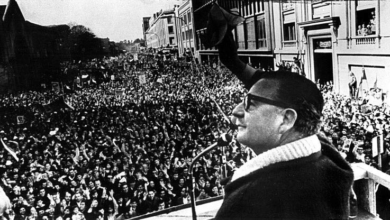In a further escalation of repression against the people’s movement in Oaxaca, led by the Popular Assembly of the People of Oaxaca (APPO), Mexico’s Federal Preventative Police (PFP) moved into the center of Oaxaca City on Oct. 29 and attacked barricades set up by APPO. This is the most aggressive government action to date. The aim of the repression is to crush the broad coalition formed in June to bring down Oaxaca’s corrupt governor Ulises Ruiz Ortiz.
The state offensive began that morning as thousands of police arrived in full riot gear. Numerous barricades made of
 |
Although many people on the frontlines were members of APPO, others came out in solidarity, to bring food to the barricades or to participate in the people’s resistance. Three demonstrators drew their own blood to write slogans against the police.
The police employed violent means to retake the city center. They used water cannons, tear gas, long batons, armored vehicles and helicopters.
In response, APPO’s security commission ordered a tactical retreat from the city’s zócalo (square). The zócalo housed a large encampment of workers and farmers. It has been the center of the struggle for several months.
APPO left the zócalo and moved to the nearby Radio Universidad area. Gustavo Martínez, member of the security commission, had announced that the PFP were seeking to take the radio station—the voice of the movement and a key strategic asset.
Radio Universidad is still under APPO control, but the zócalo was stormed by the police. In a radio broadcast following the attack, APPO’s security commission instructed the people to stay calm, avoid the police, isolate provocateurs and continue to light fires to create smoke and obstruct government aerial operations. (Radio Ke Huelga, Oct. 29)
As of Oct. 30, 50 people have been detained and two protesters have been confirmed dead. The police continue to conduct house searches throughout the city. Although some barricades are still under APPO control, bulldozers have begun removing barricades and the police have retaken several government buildings.
Vicente Fox orders police violence
The PFP arrived in Oaxaca on Oct. 28, the day that Mexico’s capitalist president, Vicente Fox, announced an ultimatum demanding that APPO give up all occupied streets, city squares, government buildings and any private property in its possession.
The previous day was the first of a three-day general strike called by APPO after paramilitaries—all supporters of Ruiz—killed 4 people and wounded 30. Among the dead was New York City Indymedia reporter Brad Will. Under the pretext of “containing the violence” that had been caused by the government, Fox took the opportunity to escalate repression against the people’s movement.
A showdown with the federal government had been in the making for several weeks. On Sept. 25, Fox had declared that he intended to end the conflict before his term expired on Dec. 1.
APPO has always stated that it was open to dialogue, but remained firm that it would not hand over the city to the police. APPO spokesperson, Florentino López, called APPO members and supporters to reinforce the barricades and protect the city center.
A statement released on Oct. 3 by APPO sheds light on Fox’s intent: “Since last week there have been aerial operations on the part of the armed forces, mobilization of troops from the PFP, the Army and the Navy as part of preparations for an intervention in Oaxaca.” (PSLweb.org, Oct. 10)
Meeting the people’s demands for justice as an alternative to violence was not considered by the capitalist government in Mexico City.
APPO an instrument of people’s power
APPO was formed in response to a June 14 police assault against teachers who had been on strike since May 22. The government violence sparked a mobilization of several leftist, labor and indigenous groups and individuals that turned the economic strike into a political movement. The diverse coalition is bound together by one major point of unity: the ouster of Oaxaca’s governor Ruiz.
Since then, APPO has evolved into an instrument of people’s power that has paralyzed the government. It has
 |
In its short existence, the movement has not only scored many victories, but also developed tremendous discipline. After taking over 12 radio stations in Oaxaca in August, APPO decided to give up several to better protect the remaining stations.
The recent Oct. 29 withdrawal from the zócalo to Radio Universidad was a necessary move that reflected the balance of forces on the ground. Knowing when to move forward and when to retreat can be a decisive factor in any struggle.
The people have relied primarily on rocks, sticks, burning tires and barricades for self-defense. In spite of the people’s unquestionable courage, they are presently no match militarily for the well-armed state.
Political struggle has literally become a matter of life or death for the movement in Oaxaca. Despite the loss of some ground to the federal forces, APPO and its supporters continue to stand firm and resolute.
An emergency call for demonstrations in solidarity with the people of Oaxaca has gone out around the world. In the United States, protests are scheduled this week at the Mexican consulates in Los Angeles, San Francisco, Chicago, New York, Miami and Houston, and at the Mexican Embassy in Washington, D.C., to denounce the Mexican government’s violence and repression. Click here to read the ANSWER Coalition’s call to action.
It is critical that progressives and revolutionaries in the United States mobilize to support this struggle.
Justice for the people of Oaxaca!





